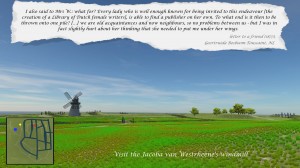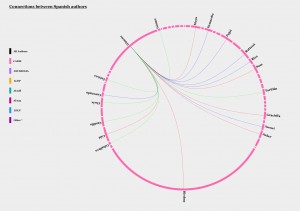At the Knowledge Exchange Workshop “Women’s History: Research, Dissemination and the role of the Digital” taking place in the KB National Library of the Netherlands on September 29 – 30, 2015, two interactive installations were presented realized in an interdisciplinary collaboration coordinated by Dr. Aleš Vaupotič from the University of Nova Gorica.
Visualization of selected quotations of Dutch women writers in 3D virtual space
Receptions—materialized as quotations—of Dutch women writers are presented in an interactive 3D virtual space. The reading of quotations is embedded in a landscape: the quotations appear along the walks between the objects in the space that represent writers of receptions and the women writers and thus connect them. However, the reading is also linear, since the paths between the women writers become available only after the user has read the previous text-fragments. The visualization explores ways of the linear reading of network-based text in space.
Presentation concept for Dutch literary field focusing on women writers and quotation selection: Dr. Suzan Van Dijk, Huygens Institute for the History of Netherlands. Concept for spatialized reading: Dr. Narvika Bovcon, University of Ljubljana, and Dr. Aleš Vaupotič, University of Nova Gorica. 3D space design and coding: Jernej Grosar. Mentors: Dr. Narvika Bovcon, Assist. Jure Demšar, Faculty of Computer and Information Science, University of Ljubljana. Game engine: Unity3d. 3D models: http://tf3dm.com, www.assetstore.unity3d.com.
Visualization of connections between Spanish women writers
The interactive visualization shows three types of connections between Spanish women writers: level 1 connection—unilateral awareness but no interaction, level 2 connection—literary acquaintance (mutual), level 3 connection—strong literary collaboration/friendship/family. The connections can be filtered also according to the literary magazines, where the writers published their work. The visualization represents a research tool that enables an informed user, i.e. a researcher, to gain an overview of a large array of relationships by means of visual language.
Presentation concept for Spanish literary field and data preparation: Judith Rideout, University of Glasgow, and Dr. Aleš Vaupotič, University of Nova Gorica. Visualization design and coding: Marija Đurđević. Mentors: Dr. Narvika Bovcon, Assist. Jure Demšar, Faculty of Computer and Information Science, University of Ljubljana. Software: Processing.
For more information please contact Aleš Vaupotič. ales.vaupotic@ung.si

